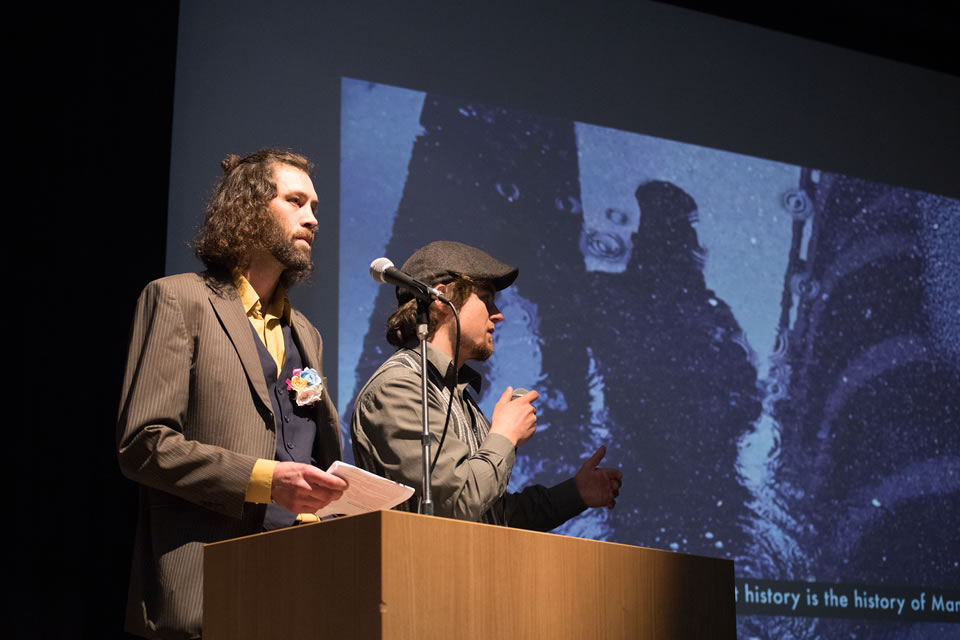PRESENTATION
We studied at the same academy and got to know each through exhibitions. Because we knew each other’s work, we naturally gravitated to collaborating together. For this work, we decided to include a message in a movie of single shots and transform it into a film. We discussed how to make this film over and over again for two days and two nights while drawing sketches. Through this process, we arranged the mythical components and metaphors along a storyline. Our journey began with the desire to capture the visual language of epic poetry on film.
Most people conjure up a completely white world in their mind when they hear the word “arctic.” But in fact, whiteness has shadows of varying intensity. The arctic also has the shadow of polar imperialism looming over it as well as the context of its rising importance.
In the prologue, against a white backdrop a human pulse is stuffed into a black plastic bag driven by a machine that feeds on a portable gasoline generator in the white landscape. Next, we move to the scene where the main character enters. We reveal to the viewer the shadow of an unnamed white creature on the white background. We proceed through the story with the main character without the viewer knowing what the main character is. We walk with the main character, step by step, through the story all the while immersed in whiteness.
The following scene depicts cod fishing, and the second main character of the epic poem appears. The story turns to wondering whether the codfish is really a fish or not. The locals depend on cod fishing for their livelihoods, and the codfish was the fundamental note around which they formed their society. This is why the codfish is the second main character, but it is just a symbolic one. The viewing side, then, expands on the story from this point.
Even if you don’t understand the story, you can still enjoy its components and the composition. For example, we are thrilled when people say things like “the snowman creature really caught my eye” or “the scene of the Russian general taking down the flag is exactly my photo.” We shot moving pictures. That’s why it doesn’t matter even if the response was “this is good” after cutting a scene. We seek out and welcome intuitive reactions.
We recorded all the scenes in the film between 11 at night and three in the morning. Outside we were engulfed in a night that was dimly lit but definitely not dark. This time allowed us to capture many beautiful shadows in the whiteness. We did not apply any artificial editing at all to the film. We are happy if the viewer senses a kind of narrative in the film and thinks of it as a poem composed of moving pictures.


Judges’s Comment
Hiraki Sawa
Benjamin, you entered last year too and were chosen for an Honorable Mention Award by another judge. I remember your images from last year intensely and you caught my eye again this year. I didn’t choose your work last year because its realness was too overpowering for me. Although the subject of this year’s entry is even more powerful than last year’s, there’s more fiction and poetic elements this time around, which create misunderstandings in a good way from my viewpoint. The images are very potent, but you’ve left room for the viewer, which makes for an intriguing work.
When you shot the sequences, did you proceed with shooting after creating a movie-like storyboard, or did you just try to execute your ideas once you were out in the field?
(Benjamin Breitkopf)
We wrote out the metaphors before the shoot and then planned out the shots. We shot with the idea of having pictures from which these metaphors protruded and with the concept of connecting these pictures up to create a giant picture lined up on a wall.
(Trond Ansten)
We shot scenes that we had planned over about a month. My role was like an inventor who creates scenes. But we were very relaxed about it, and he understood my ideas and intentions perfectly, so they were reflected in the shooting. Even if there were gaps between us, we saw them as positive within the collaboration.
This thought came to me as I wondered whether your work is a movie, and again when I saw it today — this isn’t a movie; it’s more like a sculpture. Including this question of whether it is sculpture or photography makes for a great work of art.